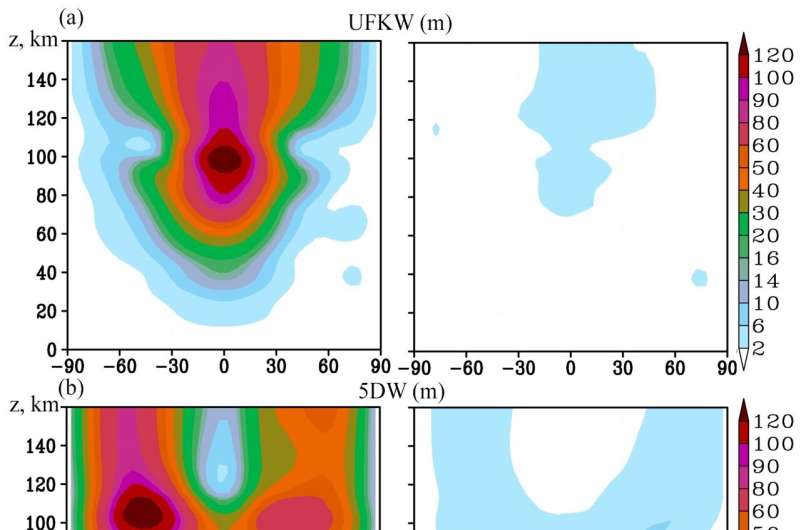This article has been reviewed according to Science X's editorial process and policies. Editors have highlighted the following attributes while ensuring the content's credibility:
fact-checked
peer-reviewed publication
trusted source
proofread
Scientists study how planetary waves affect atmospheric dynamics

Physicists at St Petersburg University have studied planetary waves and discovered that they can generate disturbances in the stratosphere causing extreme warming and cooling in the Arctic and mid-latitudes. Numerical modeling of global atmospheric circulation was carried out by researchers at the Ozone Layer and the Upper Atmosphere Research Laboratory at St Petersburg University. Their paper is published in the journal Atmospheric Chemistry and Physics.
Planetary waves are large-scale variations in the hydrodynamic parameters of the Earth's atmosphere, namely pressure, density, temperature and wind. This phenomenon is similar to the Earth's oceanic tides, where the ocean water level fluctuates over the course of a day, with differences of up to several meters. Similar "tides" exist in the atmosphere, but they are not visible to human eyes and can occur not only within a period of one day, but within time periods of up to 30 days.
Planetary waves are generated in the lower atmosphere and propagate to its uppermost layers. The amplitudes of planetary waves increase due to a decrease in the density of the atmosphere when they propagate from their sources in the troposphere. In the upper layers of the atmosphere, waves are the dominant form of motion, causing transfer of energy and momentum.
Additionally, planetary waves are the main driving force of meridional circulation, which transports air masses between the equator and the poles. Due of its global nature, the meridional circulation is considered the most important mechanism affecting the transport of aerosol, atmospheric gases and, consequently, the composition of the atmosphere.
According to the physicists from St Petersburg University, changes in the meridional circulation can affect the behavior of the ozone layer. The state of the ozone layer has attracted increased attention in the recent years due to global ozone depletion. Notably, the ozone layer acts as a "guard" of life on Earth by shielding it from the sun's harmful ultraviolet radiation, consequently affecting the climate and biosphere in general.
The researchers have developed an online course titled Space Weather: Environmental Impact Assessment. The course teaches more about the sun and solar activity, the Earth's atmosphere and the processes that occur in it and the impact of energetic particles and electromagnetic radiation on the processes in the Earth's atmosphere and the ozone layer.
Previously, the researchers revealed that powerful magnetic storms can destroy the ozone layer in the polar mesosphere, at an altitude of about 75 kilometers, by 25% per day.
The physicists from St Petersburg University have studied various planetary-wave impacts with periods in the range of three to 16 days on the general atmospheric circulation. Additionally, they studied the contribution of the 16-day planetary wave, which is regularly observed in the atmosphere, especially intensifying in winter in the northern hemisphere. Previously, such waves were studied using satellite and radar observations data. Yet, no one until now has estimated the contribution of the 16-day wave to changes in wind speed and temperature on the planet.
"Such work requires a number of numerical experiments and modeling of atmospheric circulation. We conducted such experiments and showed that the impact of just one 16-day planetary wave in an average month can change the speed of the circulation flows (winds) by up to 5%. It may seem a very small percentage, but we are talking about a global, ongoing process that has a significant impact on climate conditions, including the Earth's surface temperatures," said Andrey Koval, associate professor in the Department of Atmospheric Physics at St Petersburg University, doctor of physics and mathematics.
More information: Andrey V. Koval et al, Numerical modelling of relative contribution of planetary waves to the atmospheric circulation, Atmospheric Chemistry and Physics (2023). DOI: 10.5194/acp-23-4105-2023
Journal information: Atmospheric Chemistry and Physics
Provided by St. Petersburg State University





















